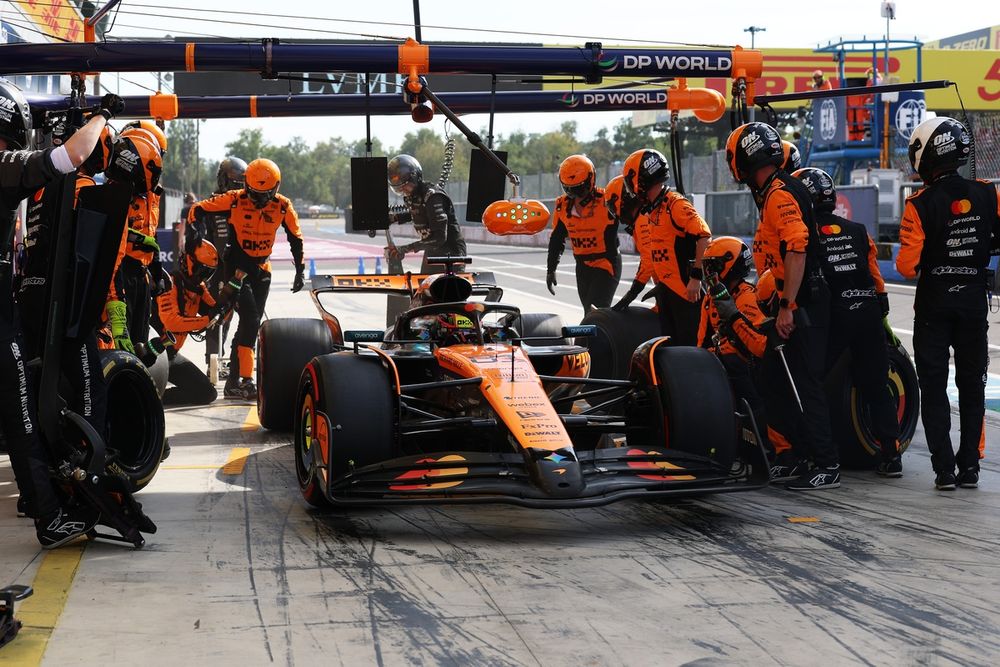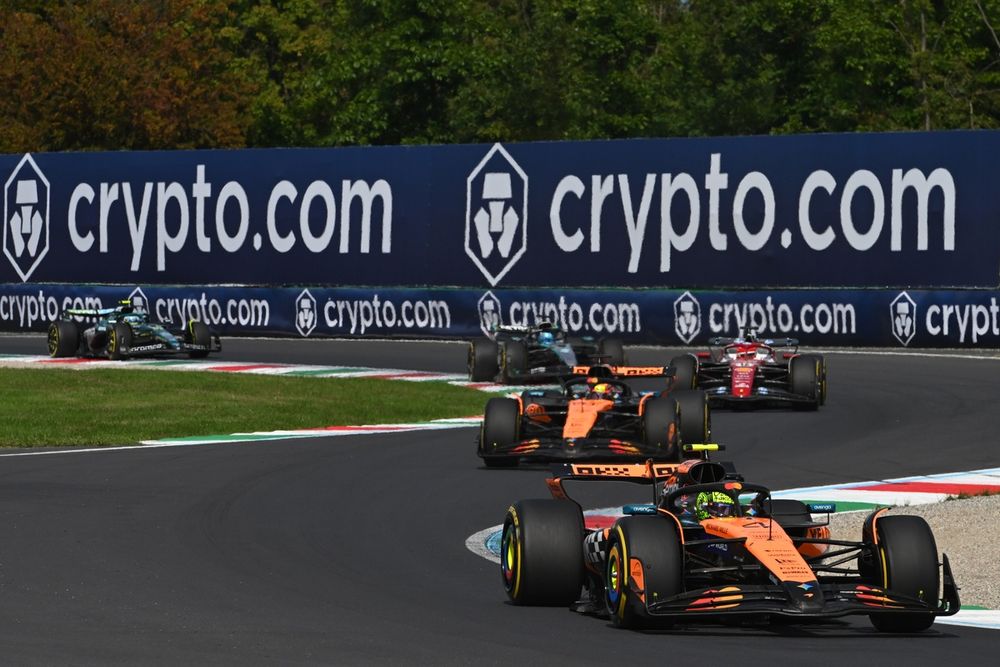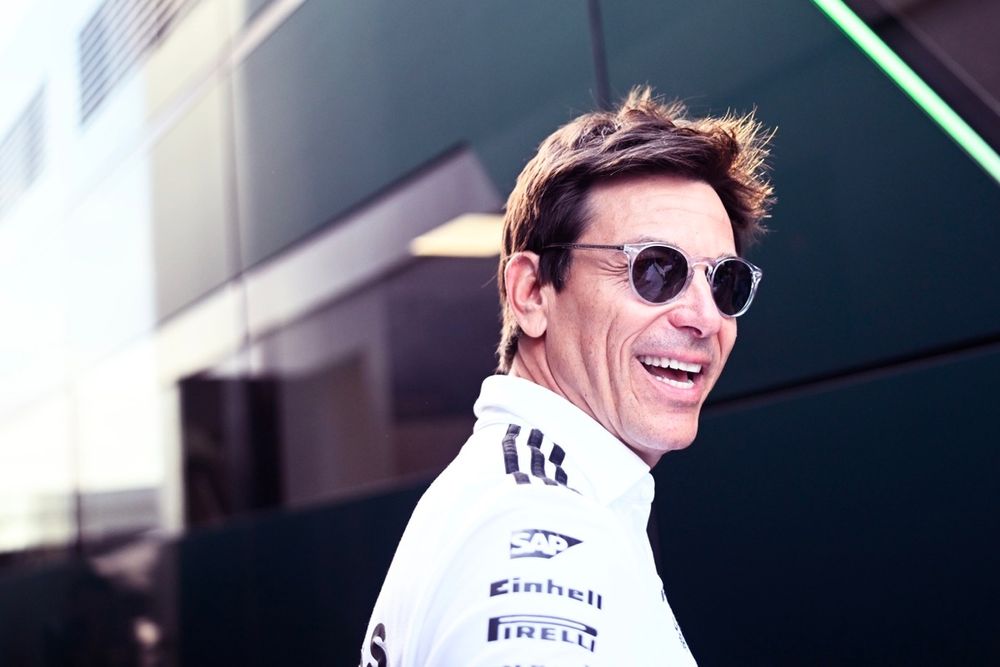Mercedes Formula 1 team principal Toto Wolff’s experience of running a team that dominated the sport for almost a decade, while also managing the internal battle between Lewis Hamilton and Nico Rosberg, makes him an interesting observer to hear from following the Italian Grand Prix.
It is no surprise that on Sunday evening, mixed in with questions about Mercedes’ overall performance in Monza and another underwhelming showing from Andrea Kimi Antonelli, the topic of McLaren’s team orders came up again and again during his post-race media session.
The call from the pitwall for Oscar Piastri to let Lando Norris through, after the Briton was delayed by some four seconds during his pitstop, sparked a debate in the paddock – for obvious reasons.
“Super interesting question,” said Wolff, when asked what he would do in such a situation. “There is no right and there is no wrong. And I’m curious to see how that pans out.”
His next sentence summed up the dilemma McLaren is facing now: “You set a precedent that is very difficult to undo.”
It is important to take into account McLaren’s point of view – and during his session with the press at Monza, which happened almost simultaneously with Wolff’s conference, McLaren team boss Andrea Stella spoke at length about how important it is not to isolate the pitstop issue from other factors that led the papaya pitwall to make the call.

Oscar Piastri, McLaren
Photo by: Steven Tee / LAT Images via Getty Images
“The situation whereby we swap the drivers is not only related to the pitstop,” the Italian first stated, “and this is useful that I clarify, it’s also related to the fact that we wanted to sequence the pitstops of the two cars by stopping Oscar first and then Lando. And we had the clear intent that this should have not led to a swap of position.
“It was just done because we were covering Leclerc, and at the same time we were waiting until the last possible moment to see if there had been a red flag or a safety car. So we pursued the team interest, and to capitalise as much as possible on this interest, we needed to go first with Oscar, then with Lando, but the clear intent was this is not going to deliver a swap of positions.
“So the fact that we went first with Oscar, compounded by the slow pitstop of Lando, then led to a swap of positions, and we thought it was absolutely the right thing to go back to the situation pre-existing the pitstop and then let the guys race.
“Had we gone first with Lando, I think even despite the pitstop, if we do the calculations with such a strong undercut power that you have on a new soft, he could have recovered quite a bit of the time lost at the pitstop.
“So for us, it was relatively simple to say the intent was that we’re not going to swap positions – and that’s why the slow pitstop compounds with this intent.”

Lando Norris, McLaren, Oscar Piastri, McLaren
Photo by: Mark Sutton / Formula 1 via Getty Images
It is indeed an important nuance: McLaren could have pitted Norris first – and he’d have had a full lap on fresh softs compared to Piastri’s used mediums to make up the difference, even if he still had a slow stop. Whether he would have emerged in front, remains debatable. But whatever the answer, McLaren pitted Piastri first because of the need to cover the distant threat from Charles Leclerc and make sure Norris was not at a disadvantage in case of a safety car.
There was, indeed, no intent to swap positions between the drivers. And it didn’t seem like the risk was there – because Piastri was still almost four seconds behind his team-mate on the lap before he dived into the pitlane.
The sequence of stops undeniably contributed to the order in which the McLaren drivers rejoined the track after their pitstops. Yet does that fully explain the bigger question around what a slow pitstop represents – and whether that is simply “part of racing”? And it was none other than Piastri himself who raised the point first – while still in the car and still running second on the road.
“I mean, we said that a slow pitstop was part of racing, so I don’t really get what’s changed here,” radioed the Australian right before informing the team that, despite lacking a degree of understanding, he wasn’t intending to disobey the order.
You’d have to admire McLaren for the excellent team culture Stella and Zak Brown have managed to build over the last few years – and it’s great to see how the drivers themselves are playing their part. Piastri and Norris both did their best to play the incident down during the official press conference, sitting on the couch on either side of Max Verstappen after the race. But when the question about that very same radio message came up, Piastri did let slip a hint that he wasn’t entirely convinced the swap was fully in line with the papaya rules.
“I think the radio call kind of says enough,” he said with a wide smile. “I’m sure we’ll discuss it again.”

Charles Leclerc, Ferrari, Lando Norris, McLaren, Oscar Piastri, McLaren
Photo by: Rudy Carezzevoli / Getty Images
And that’s where Wolff’s observations are spot on. Where do you draw the line, then?
“There’s not a clear-cut answer for today,” the Mercedes manager said. “The answer, whether managing it that way [is right], is going to come towards the end of the season – if it’s going to get more fierce. I think the team made a mistake, the team inverted the positions. Absolutely fair decision.
“On the other side, what is a team mistake? What if next time around the car doesn’t start up and you lose the position or whatever. The suspension breaks. What do you do then in the next one? So you could have a cascade of precedents that’s going to be very difficult to manage.”
What the McLaren order swap represented in the end was a six-point swing in the championship. By allowing Norris to gain a position, he was granted three more points for the Monza race – and Piastri lost the same amount.
If you take the Monza performance only into account – it was absolutely fair, as Lando was just the better of the two. So the team’s decision simply ensured everyone got what they deserved.
But does that allow Piastri to wonder – with the same performance-based, fairness-only logic applied – why the same wasn’t done in Hungary just a month ago? Because it was him who was the better driver there – and only the fact that Norris was diverted to a different strategy gave Lando the chance for victory. Back then, the decision on when to pit the drivers, and the intention behind moving Norris to a different strategy, wasn’t to make him beat Piastri. It was to overtake other cars, which the Briton fell behind after a difficult first lap. Yet no call to swap positions came in the last laps, when the Australian reeled in behind his team-mate.
The fact that some strategies work better than others in Formula 1 – even despite all the simulation tools and predictions – is, of course, just part of racing. As technical retirements are too. And slow pitstops. Or are they not?
“What if the team does another mistake and it’s not a pitstop… [do you] switch them around?” wondered Wolff. “But then equally, because of a team mistake, making a driver that is trying to catch up lose the points is not fair either. So I think we are going to get our response of whether that was right today towards the end of the season when it heats up.”

Toto Wolff, Mercedes
Photo by: Luca Barsali – NurPhoto – Getty Images
Wolff is not wrong in saying there’s “no right answer” – and right, too, in saying “there’s no wrong”.
It is a complex matter, after all. And when you’re building a “team first” culture, it’s also important to look after not only the drivers, but every other individual working for the team – including the one operating the wheelgun on the front-left corner in the pit box. But whether it would’ve been “fairer” to just accept the slow pitstop as “part of racing” is also an interesting point of debate.
It could all be forgotten at the end of the year, should Piastri go on and win the title with a comfortable gap. But what if he doesn’t? To keep the battle absolutely fair is almost impossible in such a complex sport as Formula 1 – where something as random as an oil line issue can cost a driver a huge points haul in the middle of a title fight. And it’s simply impossible to completely remove the team’s influence from the outcome of that fight.
What Monza might have done, though, is open Pandora’s box for McLaren.
In Greek mythology, Pandora was the one who released all the troubles of the world by lifting the lid she was told not to touch. Once you decide that some mistakes are part of racing and some are not, once you make fairness conditional, the lid is off – and the questions will keep coming back.
In this article
Be the first to know and subscribe for real-time news email updates on these topics

